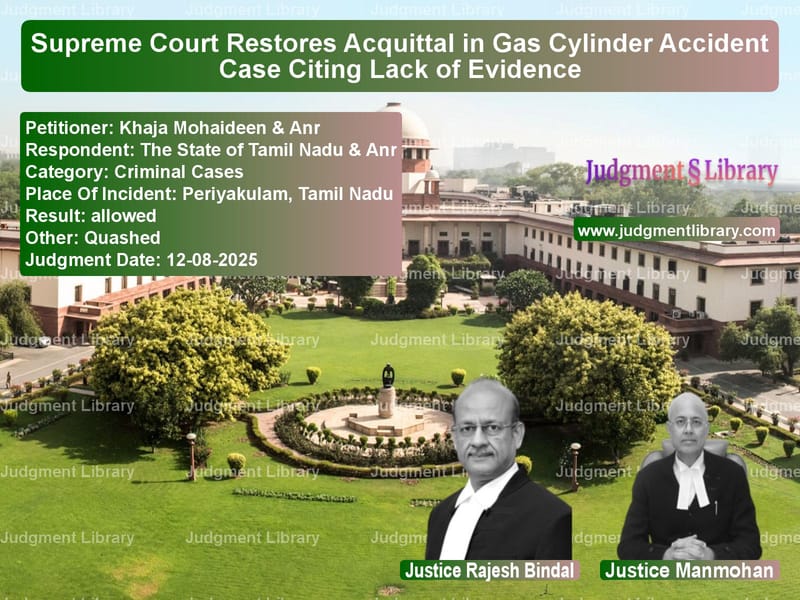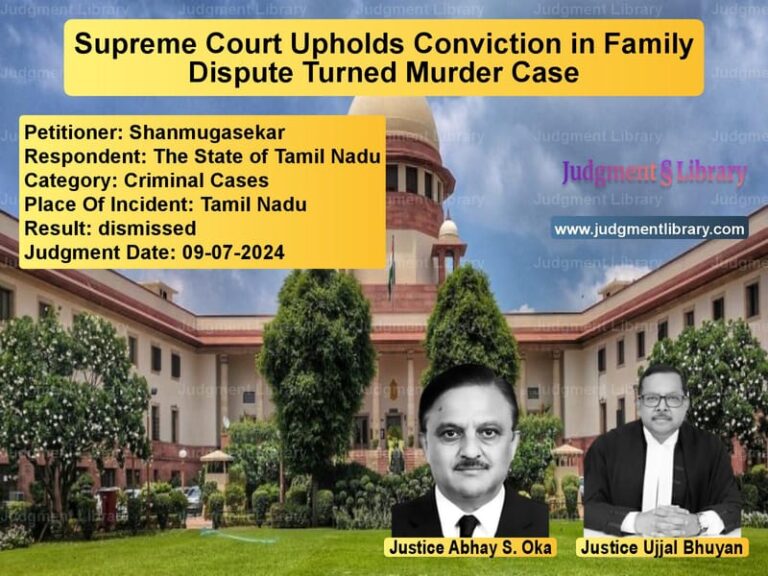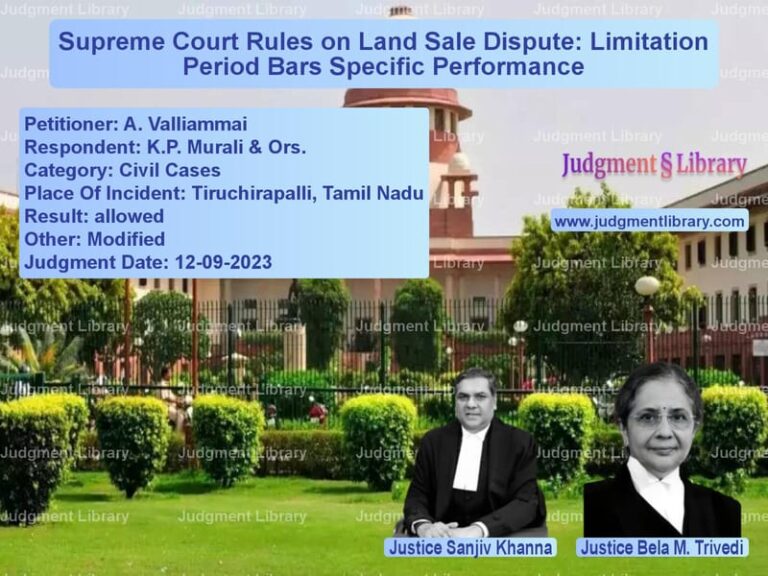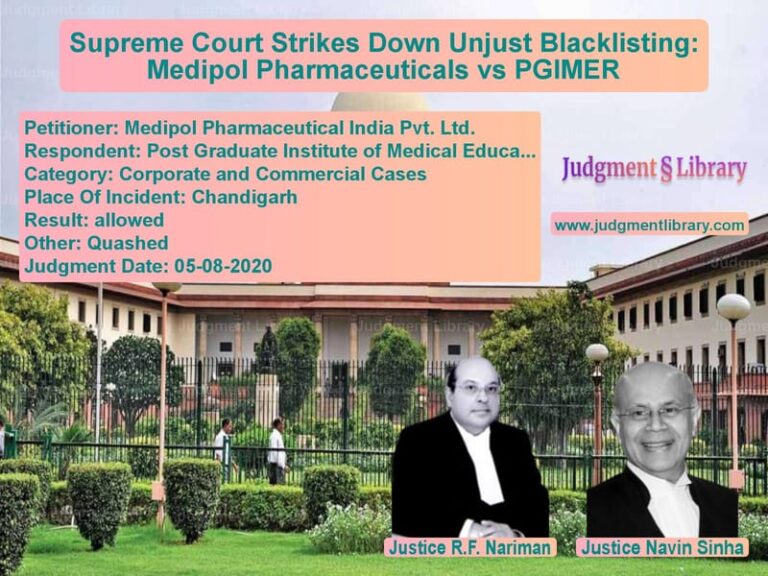Supreme Court Restores Acquittal in Gas Cylinder Accident Case Citing Lack of Evidence
In a significant judgment that underscores the importance of evidence-based convictions in criminal cases, the Supreme Court of India has restored the acquittal of two accused persons in a tragic gas cylinder explosion case that had been wrongly overturned by the High Court. The case of Khaja Mohaideen & Anr vs The State of Tamil Nadu & Anr represents a classic example of how courts must distinguish between tragic accidents and criminal culpability, emphasizing that not every unfortunate incident amounts to a criminal offense.
The case originated from a heartbreaking incident that occurred on June 14, 2005, when a gas cylinder explosion resulted in burn injuries to an entire family, including the deceased wife, her children, and her husband. The tragedy unfolded in the early morning hours when the deceased went to the kitchen to heat milk for the children. According to the evidence presented, the gas regulator had been left open overnight, causing gas to spread throughout the room. When the stove was lit in the morning, the accumulated gas ignited, causing the devastating explosion.
The legal battle that followed this tragic incident spanned nearly two decades, moving from the Trial Court to the High Court and finally to the Supreme Court. The appellants, Khaja Mohaideen (the husband) and another accused, had been charged under Sections 498A (cruelty by husband or relatives) and 306 (abetment of suicide) of the Indian Penal Code. The Additional Sessions Judge in Periyakulam, after carefully examining all the evidence, had acquitted both accused persons on March 11, 2008, finding that the prosecution had failed to prove its case beyond reasonable doubt.
The legal arguments presented before the Supreme Court highlighted fundamental questions about the scope of revisional jurisdiction and the quality of evidence required for criminal convictions. Learned counsel for the appellants made several crucial submissions, arguing that “in exercise of revisional jurisdiction, the High Court could have only examined glaring errors in the judgment of acquittal passed by the Trial Court. Re-appreciation of the evidence could not be done.” He emphasized that “the Trial Court, in the case in hand, after appreciating evidence led by both the parties had come to a conclusion that prosecution had not been able to make out any case against the appellants and acquittal was ordered.”
The appellant’s counsel specifically addressed the dying declaration, which had become a central point of contention in the case. He submitted that “the High Court had wrongly observed that the dying declaration was not properly considered.” After examining the actual content of the dying declaration, he argued that “even if the dying declaration is considered in its totality, still it does not make out a case against the appellants. It can merely be said to be an unfortunate accident. Even appellant No. 1 suffered burn injuries in the same accident when the deceased had gone to the kitchen in the early hours of morning to heat up the milk for the children.”
He further clarified the circumstances of the accident based on the dying declaration: “As is evident from the dying declaration, while sleeping at night, since the gas regulator was not closed and it remained open, the gas spread all over the room and upon lighting the gas stove in the morning, the fire spread over, causing burn injuries.”
On the opposing side, learned counsel for the respondent No.2-complainant presented contrasting arguments, contending that “the Trial Court had totally mis-directed itself in appreciating the evidence led by the prosecution.” He attempted to read implications into the dying declaration that weren’t explicitly stated, arguing that “the facts which are not even mentioned in the dying declaration, are sought to be read. It does not suggest who had left the gas supply on at night. It could have been the husband who wanted to kill the deceased.”
The respondent’s counsel further claimed that “there were instances of harassment of the wife immediately prior to the incident. If the facts are taken in their totality, it was a clear case made out by the prosecution for conviction.” He supported the High Court’s intervention by stating that “the High Court had rightly exercised its revisional jurisdiction and remitted the matter back to the Trial Court for consideration afresh. There is no error in the impugned order passed by the High Court.”
The Supreme Court, in its judgment authored by Justice Rajesh Bindal, conducted a thorough examination of the evidence and legal principles involved. The Court carefully analyzed the dying declaration that had become the centerpiece of the controversy. The judgment noted that “the dying declaration has been placed on record. It was stated by the deceased that in the fire incident which happened in early morning on 14.06.2005, the deceased as well as her children and husband sustained burn injuries. It happened as while sleeping on the previous night the gas regulator was not properly closed as a result of which all suffered burn injuries.”
The Court made a crucial observation about the content of the dying declaration, stating that “from the aforesaid dying declaration, nothing could be inferred to suggest that the deceased raised any accusation against her husband, as is sought to be suggested by the learned counsel for the respondent.”
The Supreme Court also examined the additional evidence that the respondents relied upon to support their case. The judgment addressed “the statement of the father of the deceased, who stated that after his daughter suffered burn injuries, she spoke to him the next day, and told him that the appellant No.1/husband of the deceased would kill her and marry the appellant No.2/second accused.” However, the Court found this evidence unconvincing when viewed alongside the scientific evidence.
The Court referenced the “scientific report dated 20.06.2005, available on record as Annexure P-2,” which indicated that “the cylinder and gas stove were kept inside the bedroom and as a result of fire, the entire family suffered injuries. The deceased being closest suffered highest burn injuries.” This objective evidence supported the accidental nature of the incident rather than suggesting any criminal intent.
In its final analysis, the Supreme Court reached a definitive conclusion about the futility of remanding the case back to the Trial Court. The judgment stated that “for the reasons mentioned above, we find merit in the present appeal, as it would be a futile exercise to refer the matter back to the Trial Court for fresh consideration.”
The Court’s decision to restore the acquittal was based on a comprehensive understanding that the evidence simply did not support the criminal charges brought against the appellants. The tragic incident, while devastating for the family involved, did not meet the legal threshold required for convictions under Sections 498A and 306 of the Indian Penal Code.
This judgment serves as an important reminder of several fundamental legal principles. First, it reinforces the limited scope of revisional jurisdiction, particularly when dealing with acquittals. The High Court’s power to interfere with acquittals is restricted to cases where there are glaring errors of law or procedure, not for re-appreciating evidence to reach a different conclusion.
Second, the case highlights the critical importance of dying declarations in criminal jurisprudence. While dying declarations can be crucial evidence, they must be read in their entirety and not be subject to speculative interpretations that go beyond what the declarant actually stated.
Third, the judgment underscores the distinction between tragic accidents and criminal offenses. The legal system must be careful not to criminalize unfortunate incidents without clear evidence of criminal intent or culpability.
The Supreme Court’s decision brings closure to a legal battle that has lasted for nearly twenty years, providing justice to the accused persons who had been living under the shadow of criminal charges for a tragic accident that affected their entire family. The judgment demonstrates the judiciary’s commitment to ensuring that convictions are based on solid evidence rather than speculation or emotional reactions to tragic circumstances.
This case also serves as a reminder of the importance of gas safety measures in households and the potentially devastating consequences of simple oversights like leaving gas regulators open. While the legal aspect of the case has been resolved, the tragic incident itself stands as a sobering reminder of the need for vigilance in household safety practices.
Petitioner Name: Khaja Mohaideen & Anr.Respondent Name: The State of Tamil Nadu & Anr.Judgment By: Justice Rajesh Bindal, Justice Manmohan.Place Of Incident: Periyakulam, Tamil Nadu.Judgment Date: 12-08-2025.Result: allowed.
Don’t miss out on the full details! Download the complete judgment in PDF format below and gain valuable insights instantly!
Download Judgment: khaja-mohaideen-&-an-vs-the-state-of-tamil-n-supreme-court-of-india-judgment-dated-12-08-2025.pdf
Directly Download Judgment: Directly download this Judgment
See all petitions in Domestic Violence
See all petitions in Dowry Cases
See all petitions in Suicide Cases
See all petitions in Bail and Anticipatory Bail
See all petitions in Fraud and Forgery
See all petitions in Judgment by Rajesh Bindal
See all petitions in Judgment by Manmohan
See all petitions in allowed
See all petitions in Quashed
See all petitions in supreme court of India judgments August 2025
See all petitions in 2025 judgments
See all posts in Criminal Cases Category
See all allowed petitions in Criminal Cases Category
See all Dismissed petitions in Criminal Cases Category
See all partially allowed petitions in Criminal Cases Category







